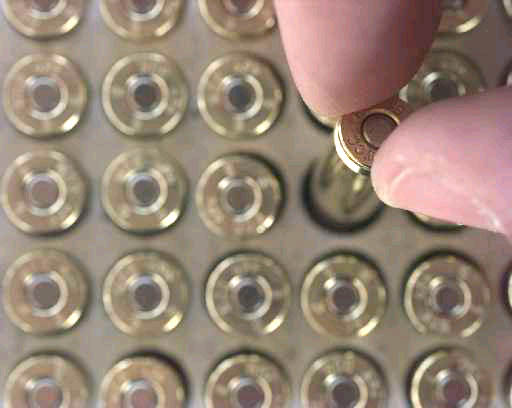Study: ‘Green’ Training Ammo Carries Cancer Risk

In the 1990’s the U.S. Army introduced a new set of "green" training ammunition designed to be less toxic and more environmentally friendly than the lead-filled rounds used before. But these new bullets may have left firing ranges contaminated and exposed soldiers to a new health hazard. Soon-to-be-released research suggests that a key element in the new ammo, once thought to be safe, may in fact be carcinogenic. The Army has stopped production of the bullets.
More than 90 million rounds of the "green" training ammunition has been used in the United States, since its introduction. It relies on a blend of tungsten and nylon, or tungsten and tin. That gives the bullets the same density and firing properties as the original, but without using lead. Tungsten was considered non-toxic. And it was thought to be "non-mobile," unlikely to dissolve and travel, so it wouldn’t get into the groundwater.
But new research by University of Arizona Research Professor of Pediatrics Mark Witten points to a different conclusion: Tungsten may elevate the risk for cancer.
His study — to be presented later this month at the 2009 Experimental Biology Meeting in New Orleans — is sponsored by the U.S. Environmental Protection Agency. The agency wanted to take a fresh look at leukemia clusters in Fallon, Nevada, and Sierra Vista, Arizona. Nearby tungsten mining appears to have raised tungsten levels in the towns.
In his research, Witten exposed mouse embryos to both airborne and waterborne tungsten, followed by a common respiratory virus. This was an attempt to replicate events preceding the Fallon leukemia cluster. Four of the six mouse pups showed abnormal leukocytes, a precursor to leukemia.
It’s a small sample size, to be sure. But Dr. Witten is in no doubt that tungsten is dangerous.
"I do believe that tungsten has deleterious health effects, and that further work is needed to understand and quantify the cancer risk," he says.
Previous research has shown that embedded tungsten alloy shrapnel is carcinogenic. This is the first time, however, that the element has been implicated. Witten’s paper does not prove that tungsten is carcinogenic. But it certainly points to the need for further research.
The Army is concerned enough about possible risks that it has stopped making the tungsten ammo. "The U.S. Army developed a lead-free 5.56mm round during the mid 1990s with a tungsten-nylon alternate slug materiel. Environmental studies later determined that the tungsten-nylon combo had a possible environmental impact. The
Army stopped production of its tungsten-nylon 5.56mm [rounds]," Tonya Townsell, a spokesperson for the Army’s Armament
Research, Development and Engineering Center, tells Danger Room. "The residual inventory of 5.56mm Tungsten-Nylon rounds is still available for use in training at lead-restricted sites as it is deemed safer than lead."
In the meantime, several facilities are cutting back their use of tungsten-based training ammo. The rounds are no longer used at
Massachusetts Military Reservation after the governor issued a "cease and desist" order. Last September, the Army Ammunition Plant in
Missouri reportedly sold 190,000 pounds of tungsten including "bullets in various stages of production" in what one commentator described as "a fire sale".
There have been growing concerns about tungsten for some years. An October 2008 Issues Paper from the state and federal waste managers’ group says that the
"original position of the scientific community with regard to fate and transport, analytical testing and toxicology" of tungsten has
"drastically changed."
The report further warns: "Over the past years, soil and groundwater samples collected at certain small arms ranges have demonstrated that tungsten is very mobile and soluble once it is released into the environment. In addition, limited yet important health studies have also revealed that tungsten may pose risks to humans and ecological receptors."
The paper notes that many training sites are still using tungsten munitions. Given that airborne tungsten is a potential hazard, anyone using a firing range with the "green" ammunition may have been exposed to a cancer risk.
There are also other ways in which military tungsten gets into the environment. The only documented case of acute tungsten poisoning in medical literature comes from a French artilleryman who drank wine that had been poured down a gun barrel as part of an initiation ritual. The barrel was a new type incorporating tungsten alloy, and particles were picked up by the wine. The soldier suffered from seizures and kidney failure, but recovered after five months. (His comrades threw up the mixture before they could suffer toxic effects.)
Cleaning up the firing ranges and checking the possible health effects of the tungsten training rounds will be a big task. Dr.
Witten, for one, has no doubt that the tungsten rounds should not be used until further work is carried out: "Maybe lead is not as dangerous as tungsten."
But there’s also a bigger task ahead. As well as training rounds, tungsten is used in a huge variety of combat munitions from bombs to missiles to tank shells, and replacing these will be a huge challenge.
[Photo: Department of Defense]


